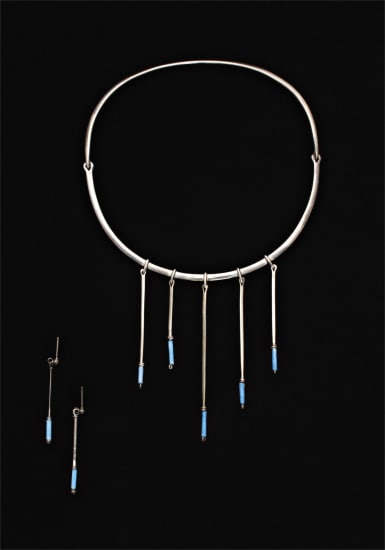Vivianna Torun Bülow-Hübe ‘Jazz’ necklace and pair of earrings 1948 Necklace: bronze, ebony; each earring: ebony, brass (3). Necklace: 11 cm. (4 1/4 in.) diameter, 12 cm. (4 3/4 in.) drop; each earring: 5.5 cm. (2 1/4 in.) drop
Catalogue Essay In an undated press photograph from the 1950s, Billie Holiday croons in a sequin dress and a triumphant pair of earrings. They threaten to steal the show. At any rate they sing, just like Lady Day. Those earrings (and the present lot) were made by Vivianna Torun Bülow-Hübe, celebrated Swedish jeweller, peripatetic, lover of jazz. She befriended Holiday in the 1950s in Paris, where Torun lived at the time with her third husband, American painter Walter Coleman. “We moved mostly in jazz circles”, she remembered, a tight orbit centered on Leroy Haynes’s soul food restaurant in the Quartier Pigalle. One can imagine Holiday—late in life, late at night—belting ‘Billie’s Blues’ in Torun’s hair comb and rock crystal drops. “Diamonds have a killing effect on a woman’s beauty,” Torun told The Star Weekly in 1962. She eschewed precious stones in favor of humbler materials: silver, rattan, moonstone, quartz—and pebbles gathered on the Riviera, where she maintained a workshop. Picasso once caught her picking stones at the beach. The meeting led to a pair of cufflinks and an exhibition of Torun’s work at the Musée Picasso, Antibes in 1958. She joined him again in 1961 when Connaissance des Arts profiled a selection of artist’s jewellery including works by Picasso, Braque, Dalí, Calder, and Torun, the sole woman and the sole craftsman in the group. “It should be possible to hang up the washing while wearing my jewellery,” she said. Torun designed for living, not voguing, “to be, not to seem”. Her fluid forms—figure eights and Möbius strips—are anatomical and conform to the movements of the body. Figure skating as a Malmö schoolgirl, she said, had taught her how to express curves. In 1959 Torun made her famous ‘Mobile’ necklace, a continuous length of silver, open and asymmetric, which wound round throat, over shoulder, and terminated in a rock crystal pendant—“a milestone in the history of modern jewellery,” wrote Barbara Cartlidge. The necklace upset formal considerations of jewellery as circuit and enclosure and won Torun the Lunning Prize and a Gold Medal at the 12th Milan Triennale, both in 1960. Torun handmade all her own work until 1967, when Danish firm Georg Jensen assumed production of her designs. Torun’s work is in the permanent collections of the Museum of Modern Art, the Musée des Arts Décoratifs, and Die Neue Sammlung. Read More
Vivianna Torun Bülow-Hübe ‘Jazz’ necklace and pair of earrings 1948 Necklace: bronze, ebony; each earring: ebony, brass (3). Necklace: 11 cm. (4 1/4 in.) diameter, 12 cm. (4 3/4 in.) drop; each earring: 5.5 cm. (2 1/4 in.) drop
Catalogue Essay In an undated press photograph from the 1950s, Billie Holiday croons in a sequin dress and a triumphant pair of earrings. They threaten to steal the show. At any rate they sing, just like Lady Day. Those earrings (and the present lot) were made by Vivianna Torun Bülow-Hübe, celebrated Swedish jeweller, peripatetic, lover of jazz. She befriended Holiday in the 1950s in Paris, where Torun lived at the time with her third husband, American painter Walter Coleman. “We moved mostly in jazz circles”, she remembered, a tight orbit centered on Leroy Haynes’s soul food restaurant in the Quartier Pigalle. One can imagine Holiday—late in life, late at night—belting ‘Billie’s Blues’ in Torun’s hair comb and rock crystal drops. “Diamonds have a killing effect on a woman’s beauty,” Torun told The Star Weekly in 1962. She eschewed precious stones in favor of humbler materials: silver, rattan, moonstone, quartz—and pebbles gathered on the Riviera, where she maintained a workshop. Picasso once caught her picking stones at the beach. The meeting led to a pair of cufflinks and an exhibition of Torun’s work at the Musée Picasso, Antibes in 1958. She joined him again in 1961 when Connaissance des Arts profiled a selection of artist’s jewellery including works by Picasso, Braque, Dalí, Calder, and Torun, the sole woman and the sole craftsman in the group. “It should be possible to hang up the washing while wearing my jewellery,” she said. Torun designed for living, not voguing, “to be, not to seem”. Her fluid forms—figure eights and Möbius strips—are anatomical and conform to the movements of the body. Figure skating as a Malmö schoolgirl, she said, had taught her how to express curves. In 1959 Torun made her famous ‘Mobile’ necklace, a continuous length of silver, open and asymmetric, which wound round throat, over shoulder, and terminated in a rock crystal pendant—“a milestone in the history of modern jewellery,” wrote Barbara Cartlidge. The necklace upset formal considerations of jewellery as circuit and enclosure and won Torun the Lunning Prize and a Gold Medal at the 12th Milan Triennale, both in 1960. Torun handmade all her own work until 1967, when Danish firm Georg Jensen assumed production of her designs. Torun’s work is in the permanent collections of the Museum of Modern Art, the Musée des Arts Décoratifs, and Die Neue Sammlung. Read More



.jpg)
.jpg)
.jpg)







Testen Sie LotSearch und seine Premium-Features 7 Tage - ohne Kosten!
Lassen Sie sich automatisch über neue Objekte in kommenden Auktionen benachrichtigen.
Suchauftrag anlegen